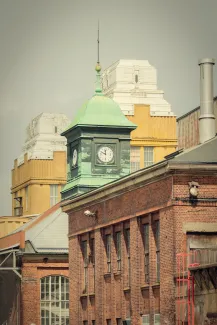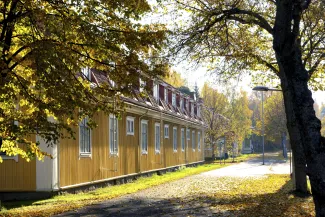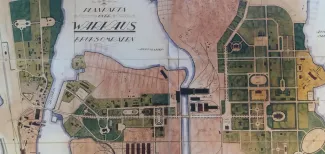Old Varkaus - better than you think you know
In Varkaus Old Town, you can experience both the history of the city's past decades and its present, amidst the lives of its residents and its working industry. Come and be amazed!
Varkaus, with a population of almost 20 000, is located in the southern part of Northern Savonia. Varkaus is a town where anyone would be well advised to stop by on a passing trip or even just to run an errand. One reason for this is Old Varkaus.
Old Varkaus is at the heart of the city's history, and its industrial history is still strongly felt in the streets, buildings, factories and parks. Old Varkaus is a small and compact area where you can find many things within a radius of one kilometre, as industry, culture, nature and old and new live side by side in close interaction.
Here you can experience culture, see art, visit cafés, visit charming shopping areas and explore interesting museums. The area is also home to some of the most beautiful urban landscapes, where you can wander from gentle groves to sparkling waterfalls. Old Varkaus also offers a wide range of accommodation for your trip, from quaint workers' cottages to full-service hotels and restaurants. Next door, in harmony with history and modern residents, hums the humming of working industry - the beating heart of Varkaus.
Sites and Actors in Old Varkaus
Old Varkaus - a Sightseeing Tour
Vanhan Varkauden Taiteiden Yö
About the Area
Varkaus is a utopia come true
Varkaus - and Old Varkaus at its heart - is a utopia come true, because the design did not just start from an industrial community, but also built the future town and city. Industrial development measures laid the foundations for growth in the early 20th century. The development of the mills into a comprehensive wood-processing plant triggered a major building boom in the early 1900s, and the area was still practically a blank sheet of paper, although some of the Ruukki that had stood on this site had been saved from the mid-19th century. However, a plan for growth was needed.
Varkaus is very exceptional as a city, as nowhere else in Finland has the first town plan for the area been implemented in the same almost one-to-one manner as it was in Varkaus. What is even more exceptional is that it all still exists. The area has a huge number of interesting layers of buildings, which invite lovers of architecture and architectural heritage to visit.
The cultural heritage of Varkaus invites you on an expedition
The old wooden houses and factories of Varkaus are an attraction in themselves. Three nationally significant built heritage sites are located in the area: the Päiviönsaari centre, the factory area and the Kommila and Kosulanniemi residential area. The interweaving of wooden houses, 50s apartment buildings and early 20th century museum and factory buildings is an important part of the built cultural and industrial heritage.
The area is still today a centre of modern technology companies, and many industrialists are housed in old factory buildings that have survived to this day. Here, industrial history has not been destroyed, but the past has been given its rightful place in the present.
The History of Old Varkaus
Nature has provided Varkaus with the conditions both for people to live and work here, and for industrial activities to take place. Varkaus's location on the banks of rivers with abundant water and a sufficient waterfall height, and in the middle of forested areas, has been specially created for the forest industry. Varkaus has had natural conditions for the supply of wood raw materials, the use of hydroelectric power as a source of energy and transport by water. As regards natural resources, lake ore has also played an essential role in the early industrial development of Varkaus.
Varkaus is mentioned in documents relating to Savonia as early as 1526, when Pekka Kolehmainen announced that he had sold his Varkaus estate to Erik Fleming for 20 Riga marks. The farm had reportedly been inhabited since the end of the 15th century. Fleming was one of the marketeers of the time, and under his ownership the farm became what is believed to be the first rälssi farm, or tax-free land, in Savonia. In the mid-15th century the farm was divided, first into two and later into several separate farms. According to the 1561 tax assessment deed, the present Kosulanniemi, Kommila and Päiviönsaari areas were owned by Paavo and Heikki Kosonen.
In the late 1700s, Päiviönsaari was the site of an army depot, and later a naval base, Laivalinna, was established there, when the area was taken over by the Crown. After Finland came under Russian rule, the base was closed, but the craftsmen and some of the soldiers from Laivalinna remained in the area, later joining the staff of the foundry.
Freeman Gustaf Wrede, who had several connections with Varkaus, received permission from the Senate on 20 April 1815 to establish a foundry near Huruskoski (now Voimakanava) and Ämmäkoski on Päiviönsaari. The state gave him the land without compensation and with full ownership rights. Since then, Päiviönsaari has followed the ownership of the factory.
With great plans and hopes, the Varkauden ironworks began operations in 1820, but the results were limited because the ore from nearby lakes was of poor quality. However, Wrede's pioneering work attracted the attention of big businessmen. Erik Johan Längman from Helsinki and Paul Wahl from Vyborg bought the foundry and the associated premises in 1834. Their aim was to set up a large sawmill business alongside the pottery, and they also envisaged building a machine shop. Längman was the manager of the pottery, but even in his time the business did not take off. Längman became indebted to his partner and soon the pottery was taken over by Wahl.
The foundry was still booming at the end of the 19th century, but in 1907 the company ran into difficulties when the Russian Council of Ministers decided that no more state orders would be given to Finnish machine shops. The indebted Paul Wahl & Co ended up selling the pottery to Ahlström Oy, which turned its attention to the wood processing industry, for which Varkaus was an ideal location.
To succeed, Ahlström had to look beyond industrial investments. In addition to the forest industry plants, roads and bridges were built, as well as housing and various facilities for workers and clerks. The company was also responsible for medical care, schools, parish work, a library, a fire brigade, public order and social welfare.
The growth of the factory caused Varkaus to increase in population and to become more "urban". Walter Ahlström commissioned Valter and Ivar Thomé to draw up Varkaus' first town plan in 1913.
The plan placed industrial buildings along Huruskoski and Pirtinniemi, administration and services on Päiviönsaari, and housing in the surrounding areas of Kommila and Kosulanniemi. The areas were connected by a wide park street, Ahlströminkatu, planted with lime trees, which gave the area an urban character.
The Kommila-Kosulanniemi residential area, built according to the garden city ideals, was also the site of the modern church of the community. The layout of the dwellings followed the hierarchy of the ruling society: the factory management lived in their own area, as did the officials, masters and workers.
In 1923, the factory began to implement the Päiviönsaari town plan, creating a park in front of the central office with flower beds, earthworks and planting more lime trees imported from Germany. It was pointed out on several occasions at the time that "aesthetic requirements have been taken into account in both the factory buildings and the residential buildings".
The creation of the Varkauden kauppala in 1929 relieved the factory of many of its public administration tasks, but still some of the buildings remained in the care of the factory for a long time. At the beginning of 1962, Varkaus became a city. A major change at the Varkaus mills took place in 1987, when the mills were transferred from Ahlström to Enso-Gutzeit.
Today, Varkaus is a developing, competitive, environmentally friendly and international high-tech city. The city's streetscape is strongly influenced by its industrial heritage, and not only by its street names, as the building stock has been influenced over time by many prominent architects, including Valter and Ivar Thomé, Karl Lindahl and Alvar Aalto. The Old Varkaus area is a nationally significant built cultural environment and its entire building stock is protected.
Sources / Read more:
Immonen Mari ja Melaranta Hanna-Kaisa: Kerroksien kaupunki. Varkautelaisten rakennettu menneisyys. Varkauden museon julkaisuja 9. 2011
Itkonen Hannu: Tehtaan klubilta teollisuusklubille. Varkautelaisen klubitoiminnan kahdeksan vuosikymmentä (1919–1999). 2003
Melaranta Hanna-Kaisa: Matkaopas Varkauden teollisiin ympäristöihin. Varkauden museon julkaisuja 10. 2019
Moilanen Pentti: Varkauden teollisuus 175 vuotta. Varkauden museon julkaisuja IV. 1991
Soikkanen Hannu: Varkauden historia. 1963




